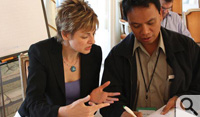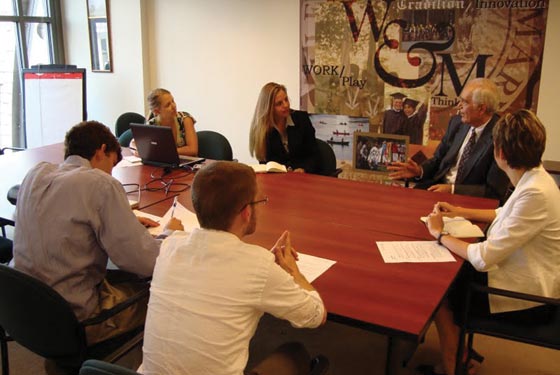It's Better to Be There
From its base in D.C., GEG engages tough problems of international environmental governance
Environmental problems have grown more acute and more global in the last 30 years, outstripping the capabilities and powers of the international institutions that were set up to contain them.
Globally speaking, Maria Ivanova says, we’re trying to address 21st-Century environmental issues—depletion of natural resources, the plague of persistent organic pollutants, climate change and many others—with a structure of governance that’s just not up to the task. But there’s no reason for environmentalists to despair.
“A new generation of environmental leaders is emerging with a highly collaborative international agenda,” she said. “And they are reaching out to the founding architects of the international environmental institutions for inspiration and lessons in statesmanship.”
The focus of Ivanova’s research is not the environmental problems per se, but rather the organizations, policies and laws established to manage, remediate and (hopefully) eliminate troubles with the environment. An assistant professor in William & Mary’s government department and a current fellow at the Woodrow Wilson International Center for Scholars in Washington, she regularly involves William & Mary students in her work with U.S. and international environmental policy issues through the Global Environmental Governance (GEG) Project.
Directed by Ivanova, the GEG Project is a partnership of the Institute for the Theory and Practice of International Relations at William & Mary and the Yale Center for Environmental Law & Policy. Its mission is to provide research and advocacy to strengthen environmental policymaking on a global level.
A base in the power base
Their base in the College’s Washington, D.C., Office gives Ivanova and her students ready access to the materials—and the policymakers—available in the nation’s capital. Adam Anthony ’87 is the director of the William & Mary Washington Office, strategically located in the Dupont Circle neighborhood. He and his staff have provided infrastructure for initiatives such as the GEG Project.
“Maria’s ‘base of operation’ here in the Washington Office makes it logistically easier for her to coordinate a large student research team and places her within a few blocks of most of the nation’s leading environmental policy experts,” said Anthony. “Her students are getting exposure to the type of policy experts and research resources not available anywhere else.”
Accordingly, the students working out of the D.C. office in 2008 were able to interview nearly a dozen heavy-hitters on the international environmental scene, including Mohamed El-Ashry, founder and former CEO of the Global Environment Facility; Dan Reifsnyder, deputy assistant secretary for environment at the U.S. Department of State; and Melinda Kimble, a senior vice president at the U.N. Foundation. Caroline Cress ’10 has been working in D.C. with Ivanova since her freshman year.
“Conducting this level of research is a rare opportunity for undergraduate students. It is also a field of research that is inherently related to important ongoing political processes, which makes the work both applicable and satisfying,” Cress said.
Putting together the ‘green hall of fame’
In the summer of 2009 Ivanova, in collaboration with Daniel Esty at Yale, convened the historic Global Environmental Governance Forum: Reflecting on the Past, Moving into the Future, which gathered several generations of environmental leaders in Glion, Switzerland, to “rediscover the past, analyze the present and imagine the future.” Cress and several other students joined Ivanova at the forum, a gathering of international environmental luminaries that some participants dubbed “the green hall of fame.”
Much of the GEG forum focused on the evolution of the United Nations Environmental Programme (UNEP), an agency created amid high environmentalist hopes in the 1970s, but which has yet to fulfill its early promise, Ivanova said.
“I view UNEP as the anchor institution for the global environment,” Ivanova explained. “They are supposed to provide leadership, to catalyze action and to coordinate the activities of the U.N. system on the environment. They’re supposed to be the global conscience for the environment.”
Ivanova is familiar with UNEP. In fact, she has taken groups of William & Mary students to visit the organization’s headquarters in Nairobi, Kenya, in 2006 and in 2008. A highlight of the Glion conference was the attendance of not only current UNEP Executive Director Achim Steiner, but every other UNEP executive director to serve since the agency’s founding in 1972—Maurice Strong, Mostafa Tolba, Elizabeth Dowdeswell and Klaus Töpfer. Also attending was Ambassador John W. McDonald, who drafted the United Nations resolutions that created UNEP while serving at the U.S. State Department in the 1970s.
“We convened the very people that imagined UNEP, drew up its blueprint, created it—and then ran it,” Ivanova said. Their participation provided the forum with a continuity that allowed the participants to examine the successes of international environmental institutions, as well as to examine their shortfalls, with an eye to moving ahead.
International consortium
 As befits an international environmental gathering, the forum was made possible by an international consortium, which included four governments, Germany, Norway, Sweden and Switzerland; the United Nations Foundation; UNEP; the UN Institute for Training and Research (UNITAR); the University of Geneva; and the Horn of Africa Regional Environment Center at Addis Ababa University in Ethiopia. The forum’s advisory board, which assisted with preparations and follow-up, was equally international and impressive: Yolanda Kakabadse, president of WWF; Julia Marton-Lefevre, director-general of the International Union for Conservation of Nature; Mehjabeen Habidi-Abib, chair of the board of directors of LEAD International; Mohamed El-Ashry, founder and former CEO of the Global Environment Facility; Philippe Roch, former Swiss environment minister; and Mark Halle, director of the European office of the International Institute for Sustainable Development.
As befits an international environmental gathering, the forum was made possible by an international consortium, which included four governments, Germany, Norway, Sweden and Switzerland; the United Nations Foundation; UNEP; the UN Institute for Training and Research (UNITAR); the University of Geneva; and the Horn of Africa Regional Environment Center at Addis Ababa University in Ethiopia. The forum’s advisory board, which assisted with preparations and follow-up, was equally international and impressive: Yolanda Kakabadse, president of WWF; Julia Marton-Lefevre, director-general of the International Union for Conservation of Nature; Mehjabeen Habidi-Abib, chair of the board of directors of LEAD International; Mohamed El-Ashry, founder and former CEO of the Global Environment Facility; Philippe Roch, former Swiss environment minister; and Mark Halle, director of the European office of the International Institute for Sustainable Development.
To fulfill its role as an “anchor institution” within the greater international community, Ivanova said that UNEP was designed as “an agile and able intergovernmental body that would bring coherence, competence and connectivity to an already fragmented institutional landscape.” The organization’s architects said at the time of its creation that they wanted to establish “a brain, not a bureaucracy,” that could incorporate environmental issues into other areas of concern such as development, health and economics and help to mediate international disputes of an environmental nature.
Created to be an effective force
“UNEP was created with good intentions,” Ivanova explained. “It was created to be effective.” The forum participants discussed the history of UNEP and traced the paths of its successes and failures. The GEG Project issued a report, “Global Environmental Governance in the 21st Century: Way Ahead Wide Open” and a pair of video documentaries based on the deliberations. In the GEG reports, Ivanova stresses that while UNEP has problems, it hasn’t been completely ineffective.
“UNEP has been weakened over the years, and its remote geographical location has also contributed to some of its marginalization within the UN system. It has not fulfilled the original vision of being the anchor, but it has succeeded in many other ways,” she said. “It has catalyzed a number of agreements on a number of environmental problems. It has put the environment on the agenda more strongly.”
One of the most vexing aspects of the history of global environmental issues is the persistence of the problems of international governance, as sovereign nations create a kind of Tragedy of the Commons as they pursue national interests at the expense of the global public good.
Current UNEP Executive Director Achim Steiner expressed surprise that the environmental governance issues being discussed today are nearly identical to where the discussions started four decades ago.
“What is striking is that whether it is 1970, 1980, 1990 or 2000, the questions have not changed,” Steiner remarked during the conference.
Ivanova said that for many attendees at the forum this lack of progress came as a surprise, but not to her.
Passing the torch
“The very purpose of the forum was to convene several generations of environmental leaders and illustrate that the questions we are grappling with today are not new and that we need to learn from the individuals who have confronted them before,” she added.
In that spirit, the GEG Forum contained a strong passing-the-torch component, with the elder statesmen of international environmental policy bringing into the fold those that Ivanova refers to as the “new generation of environmental leaders,” young professionals competitively recruited to attend the forum and five Catto Environmental Fellows from the Aspen Institute. The youngest attendees at the forum who ensured that the event ran smoothly included current William and Mary students Cress and Clare Stankwitz ’11, alumni Susanah Stoessel ’07, Jenn Hatch ’09 and Phil Hernandez ’09, and graduate students from Yale’s Environment School and the Graduate Institute in Geneva.
“To have heard these discussions and to be able to meet all of the forum participants in person will have a significant impact on how I deal with and perceive these issues in my future education and work,” said Stankwitz, another veteran of the D.C. office. “I now understand better just how difficult it can be—even in a well-researched and often-discussed field—for leaders to come to an agreement on a particular course of action, particularly on an international basis.”
For Caroline Cress, organizing and attending the GEG Forum was a capstone experience of sorts in the lead-up to her senior year.
“This summer especially acted as a complement to my academic education at William & Mary because I was actively involved in a political process which I have been researching from the sidelines for two years,” Cress said. “Just as a field lab is essential for truly learning a subject in the natural sciences, experiences such as organizing and attending the GEG Forum are essential for a full learning experience in political science.”
Cress, Stankwitz and the other students and emerging environmental leaders at Glion announced in a press release a pledge to personally commit to creating a new wave of environmental action in the 21st Century. As GEG Forum participants, they can do so with a sense of history and the original principles of the international environmental movement.
“We need to rethink these institutional mechanisms, because the problems are more acute, because they’re more global, because we understand them better,” Ivanova said. “We have to figure out a new way to pursue collective action that will deliver results. This is where the young people come in. The purpose of our project at William & Mary and Yale is to equip that new generation of environmental leaders with the right tools to be able to solve those problems.” 
















